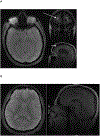Characterization of PLA2G6 as a locus for dystonia-parkinsonism
- PMID: 18570303
- PMCID: PMC9016626
- DOI: 10.1002/ana.21415
Characterization of PLA2G6 as a locus for dystonia-parkinsonism
Abstract
Background: Although many recessive loci causing parkinsonism dystonia have been identified, these do not explain all cases of the disorder.
Methods: We used homozygosity mapping and mutational analysis in three individuals from two unrelated families who presented with adult-onset levodopa-responsive dystonia-parkinsonism, pyramidal signs and cognitive/psychiatric features, and cerebral and cerebellar atrophy on magnetic resonance imaging but absent iron in the basal ganglia.
Results: We identified areas of homozygosity on chromosome 22 and, subsequently, PLA2G6 mutations.
Interpretation: PLA2G6 mutations are associated with infantile neuroaxonal dystrophy and have been reported previously to cause early cerebellar signs, and the syndrome was classified as neurodegeneration with brain iron accumulation (type 2). Our cases have neither of these previously pathognomic features. Thus, mutations in PLA2G6 should additionally be considered in patients with adult-onset dystonia-parkinsonism even with absent iron on brain imaging.
Conflict of interest statement
None of the authors has stated any conflict of interest.
Figures


Comment in
-
Dystonia-parkinsonism disease gene discovery: expect surprises.Ann Neurol. 2009 Jan;65(1):2-3. doi: 10.1002/ana.21609. Ann Neurol. 2009. PMID: 19194873 No abstract available.
-
PLA2G6 mutations and Parkinson's disease.Ann Neurol. 2010 Jan;67(1):148. doi: 10.1002/ana.21663. Ann Neurol. 2010. PMID: 20186954 No abstract available.
Similar articles
-
Phenotypic spectrum of patients with PLA2G6 mutation and PARK14-linked parkinsonism.Neurology. 2010 Oct 12;75(15):1356-61. doi: 10.1212/WNL.0b013e3181f73649. Neurology. 2010. PMID: 20938027
-
Dissecting the Phenotype and Genotype of PLA2G6-Related Parkinsonism.Mov Disord. 2022 Jan;37(1):148-161. doi: 10.1002/mds.28807. Epub 2021 Oct 8. Mov Disord. 2022. PMID: 34622992
-
Clinical heterogeneity of PLA2G6-related Parkinsonism: analysis of two Saudi families.BMC Res Notes. 2016 Jun 7;9:295. doi: 10.1186/s13104-016-2102-7. BMC Res Notes. 2016. PMID: 27268037 Free PMC article.
-
Genotype-phenotype correlations of adult-onset PLA2G6-associated Neurodegeneration: case series and literature review.BMC Neurol. 2020 Mar 17;20(1):101. doi: 10.1186/s12883-020-01684-6. BMC Neurol. 2020. PMID: 32183746 Free PMC article. Review.
-
PLA2G6-associated neurodegeneration in four different populations-case series and literature review.Parkinsonism Relat Disord. 2022 Aug;101:66-74. doi: 10.1016/j.parkreldis.2022.06.016. Epub 2022 Jun 30. Parkinsonism Relat Disord. 2022. PMID: 35803092 Review.
Cited by
-
Analysis of EIF4G1 in ethnic Chinese.BMC Neurol. 2013 Apr 26;13:38. doi: 10.1186/1471-2377-13-38. BMC Neurol. 2013. PMID: 23617574 Free PMC article.
-
PLA2G6 Mutations Related to Distinct Phenotypes: A New Case with Early-onset Parkinsonism.Tremor Other Hyperkinet Mov (N Y). 2016 Mar 16;6:363. doi: 10.7916/D81G0M12. eCollection 2016. Tremor Other Hyperkinet Mov (N Y). 2016. PMID: 27127721 Free PMC article.
-
Typical MRI features of PLA2G6 mutation-related phospholipase-associated neurodegeneration (PLAN)/infantile neuroaxonal dystrophy (INAD).BMJ Case Rep. 2021 Mar 25;14(3):e242586. doi: 10.1136/bcr-2021-242586. BMJ Case Rep. 2021. PMID: 33766980 Free PMC article. No abstract available.
-
Lysophosphatidylcholine binds α-synuclein and prevents its pathological aggregation.Natl Sci Rev. 2024 May 25;11(6):nwae182. doi: 10.1093/nsr/nwae182. eCollection 2024 Jun. Natl Sci Rev. 2024. PMID: 38962715 Free PMC article.
-
The genetics and neuropathology of Parkinson's disease.Acta Neuropathol. 2012 Sep;124(3):325-38. doi: 10.1007/s00401-012-1013-5. Epub 2012 Jul 18. Acta Neuropathol. 2012. PMID: 22806825 Free PMC article. Review.
References
-
- Zhou B, Westaway SK, Levinson B et al. A novel pantothenate kinase gene (PANK2) is defective in Hallervorden-Spatz syndrome. Nat Genet. 2001; 28:345–349 - PubMed
-
- Ramirez A, Heimbach A, Grundemann J et al. Hereditary parkinsonism with dementia is caused by mutations in ATP13A2, encoding a lysosomal type 5 P-type ATPase. Nat Genet. 2006; 38:1184–1191 - PubMed
-
- Camargos S, Scholz S, Simon-Sanchez J et al. DYT16, a novel young-onset dystonia-parkinsonism disorder: identifi cation of a segregating mutation in the stress response protein prkra. Lancet Neurol. 2008; 7:207–215 - PubMed
-
- Kitada T, Asakawa S, Hattori N et al. Mutations in the parkin gene cause autosomal recessive juvenile parkinsonism. Nature. 1998; 392:605–608 - PubMed
-
- Valente EM, Salvi S, Ialongo T et al. PINK1 mutations are associated with sporadic early-onset parkinsonism. Ann Neurol. 2004; 56:336–341 - PubMed
Publication types
MeSH terms
Substances
Grants and funding
LinkOut - more resources
Full Text Sources
Other Literature Sources
Medical
Molecular Biology Databases

